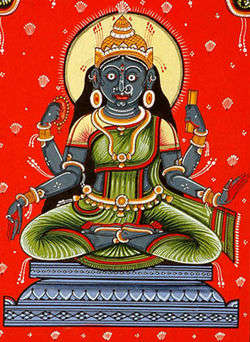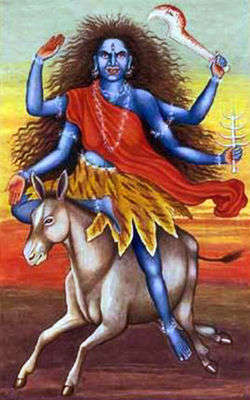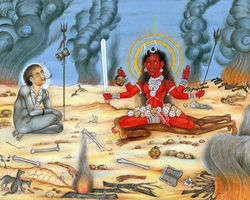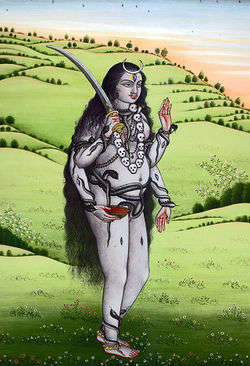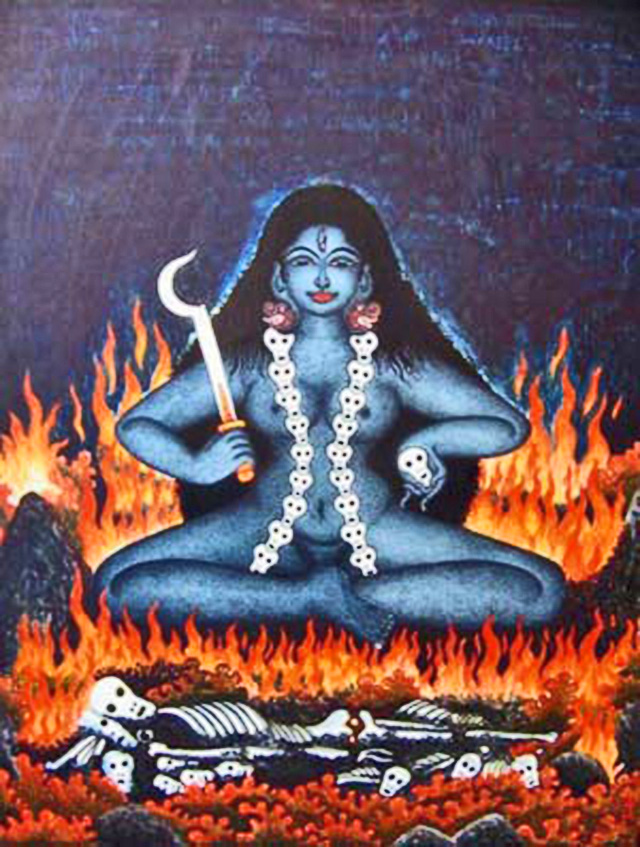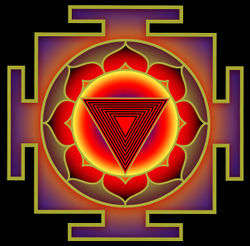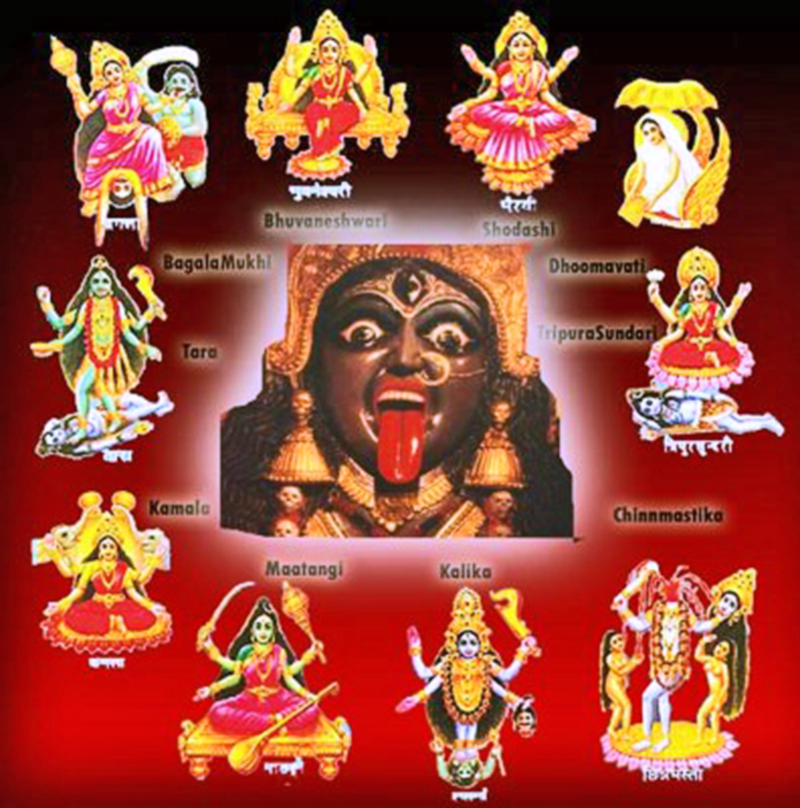Bhairavi: Unterschied zwischen den Versionen
| Zeile 11: | Zeile 11: | ||
Wie alle Mahavidyas gilt Bhairavi als eine der Formen von [http://www.yoga-vidya.de/Bilder/Galerien/Durga.html Durga], von [[Parvati]] und von [[Sati]]. | Wie alle Mahavidyas gilt Bhairavi als eine der Formen von [http://www.yoga-vidya.de/Bilder/Galerien/Durga.html Durga], von [[Parvati]] und von [[Sati]]. | ||
===Symbolik von Bhairavi=== | |||
Bhairavi is seen mainly as the Mahakali in the Durga Saptashathi version of slaying Shumbha and Nishumbha. However, she kills and drinks the blood of Chanda and Munda the Chieftains of asuras, so the Goddess Parvathi gives her a boon that she would be called Chamundeshwari. In other forms she is also identified with Parvathi or Durga. When furious she is found sitting on a faithful donkey, with her mouth full of demons' blood, her body covered with a tiger skin and skeleton. She also presents the abhaya mudra and vara mudhra, and she is shown holding weapons such as a trident, axe, and thunderbolt. | Bhairavi sitzt auf manchen Darstellungen auf ihrem [[Esel]] - dadurch ist sie einfach zu unterscheiden von Kali. Ihre Hände sind in [[Abhaya Mudra]] (Schutzgeste) und [[Vara Mudra]] (Gnade). Ihre Hände tragen Waffen wie Dreizack, Axt und Donnerkeil. Ihr Körper ist bedeckt mit einem Tigerfell und einem Skelett. | ||
Bhairavi is seen mainly as the Mahakali in the Durga Saptashathi version of slaying Shumbha and Nishumbha. However, she kills and drinks the blood of Chanda and Munda the Chieftains of asuras, so the Goddess Parvathi gives her a boon that she would be called Chamundeshwari. In other forms she is also identified with Parvathi or Durga. When furious she is found sitting on a faithful donkey, with her mouth full of demons' blood, her body covered with a tiger skin and skeleton. She also presents the abhaya mudra and vara mudhra, and she is shown holding weapons such as a trident, axe, and thunderbolt. | |||
Creation and Destruction are two essential aspects of the universe, which is continually subject to their alternating rhythms. The two are equally dominant in the world and indeed depend upon each other in symbiotic fashion. Bhairavi embodies the principle of destruction. She arises or becomes present when the body declines and decays, which is a natural, inevitable, and irresistible force. Bhairavi is also evident in self-destructive habits, such as eating tamsic food (food having a quality associated with ignorance and lust) and drinking liquor, which wear down the body and mind. She is present, it is said, in the loss of semen, which weakens males. Anger, jealousy, and other selfish emotions and actions strengthen Bhairavi's presence in the world. Righteous behavior, conversely, makes her weaker. In short, she is an ever-present goddess who manifests herself in, and embodies, the destructive aspects of the world. Destruction, however, is not always negative, creation cannot continue without it. This is most clear in the process of nourishment and metabolism, in which life feeds on death; creation proceeds by means of transformed energy given up in destruction. | Creation and Destruction are two essential aspects of the universe, which is continually subject to their alternating rhythms. The two are equally dominant in the world and indeed depend upon each other in symbiotic fashion. Bhairavi embodies the principle of destruction. She arises or becomes present when the body declines and decays, which is a natural, inevitable, and irresistible force. Bhairavi is also evident in self-destructive habits, such as eating tamsic food (food having a quality associated with ignorance and lust) and drinking liquor, which wear down the body and mind. She is present, it is said, in the loss of semen, which weakens males. Anger, jealousy, and other selfish emotions and actions strengthen Bhairavi's presence in the world. Righteous behavior, conversely, makes her weaker. In short, she is an ever-present goddess who manifests herself in, and embodies, the destructive aspects of the world. Destruction, however, is not always negative, creation cannot continue without it. This is most clear in the process of nourishment and metabolism, in which life feeds on death; creation proceeds by means of transformed energy given up in destruction. | ||
Version vom 21. Juni 2013, 11:04 Uhr
Bhairavi, Sanskrit भैरवी Bhairavī, die Furcherregende, die Schreckliche, aber auch die Furchtauflösende. Eine der 10 Mahavidyas, Weisheitsgöttinnen im Tantra. Bhairavi ist auch der Name für ein indisches Musikstück (Raga Bhairavi bzw. Raag Bhairavi). Eine Adeptin im Kundalini Yoga kann auch als Bhairavi bezeichnet werden.
Bhairavi als eine der Mahavidyas
Der Name Bhairavi heißt "Schrecken", "ehrfurchtgebietend", "furchterregend". Jemand der den Zustand von Bhairavi erreicht hat, ist jenseit der Angst vor dem Tod, daher ehrfurchtgebietend. Bhairavi wird auch Shubmkari genannt, die Gute Mutter zu den Guten - und die Furchterregende für die weniger Guten. Wenn Bhairavi auf das Schlachtfeld geht, lässt ihre furchterregende Erscheinung die Dämonen (Asuras) schwach werden. Die Dämonen fliehen, sowie sie Bhairavi sehen. So kann man Bhairavi anrufen bzw. zu ihr beten, wenn man Schutz braucht.
Bhairavi wird in der Durga Saptashati (Devi Mahatmyam) gleich gesetzt mit Mahakali. Bhairavi bzw. Mahakali tötet in der Devi Mahatmyam die Dämonen Chanda und Munda und wird deshalb auch als Chamundi bzw. Chamundeshwari bezeichnet.
Wie alle Mahavidyas gilt Bhairavi als eine der Formen von Durga, von Parvati und von Sati.
Symbolik von Bhairavi
Bhairavi sitzt auf manchen Darstellungen auf ihrem Esel - dadurch ist sie einfach zu unterscheiden von Kali. Ihre Hände sind in Abhaya Mudra (Schutzgeste) und Vara Mudra (Gnade). Ihre Hände tragen Waffen wie Dreizack, Axt und Donnerkeil. Ihr Körper ist bedeckt mit einem Tigerfell und einem Skelett.
Bhairavi is seen mainly as the Mahakali in the Durga Saptashathi version of slaying Shumbha and Nishumbha. However, she kills and drinks the blood of Chanda and Munda the Chieftains of asuras, so the Goddess Parvathi gives her a boon that she would be called Chamundeshwari. In other forms she is also identified with Parvathi or Durga. When furious she is found sitting on a faithful donkey, with her mouth full of demons' blood, her body covered with a tiger skin and skeleton. She also presents the abhaya mudra and vara mudhra, and she is shown holding weapons such as a trident, axe, and thunderbolt.
Creation and Destruction are two essential aspects of the universe, which is continually subject to their alternating rhythms. The two are equally dominant in the world and indeed depend upon each other in symbiotic fashion. Bhairavi embodies the principle of destruction. She arises or becomes present when the body declines and decays, which is a natural, inevitable, and irresistible force. Bhairavi is also evident in self-destructive habits, such as eating tamsic food (food having a quality associated with ignorance and lust) and drinking liquor, which wear down the body and mind. She is present, it is said, in the loss of semen, which weakens males. Anger, jealousy, and other selfish emotions and actions strengthen Bhairavi's presence in the world. Righteous behavior, conversely, makes her weaker. In short, she is an ever-present goddess who manifests herself in, and embodies, the destructive aspects of the world. Destruction, however, is not always negative, creation cannot continue without it. This is most clear in the process of nourishment and metabolism, in which life feeds on death; creation proceeds by means of transformed energy given up in destruction.
Bhairavi is also identified with Kalaratri, a name often associated with Kali that means "black night (of destruction)" and refers to a particularly destructive aspect of Kali. She is also identified with Mahapralaya, the great dissolution at the end of a cosmic cycle, during which all things, having been consumed with fire, are dissolved in the formless waters of procreation. She is the force that tends toward dissolution. This force, furthermore, which is actually Bhairavi herself, is present in each person as one gradually ages, weakens and finally dies. Destruction is apparent everywhere, and therefore Bhairavi is present everywhere.
One of her dhyana mantras, that of Sampatprada-bhairavi, says that she is intoxicated with her youth, and most descriptions of her, despite her association with destruction, say that she is attractive, young, and shapely. Bhairavi's association with sexual desire and fulfillment is mentioned often in her thousand-name hymns. In the Shakta-pramoda, for example, she is called She Who Is Fond of Semen and Menstrual Blood and She Who Is Worshiped by Those Who Worship with Semen. In her thousand-name hymn in the Vishvasara-tantra, she is called Lovely One, She Whose Form Is Semen, Who Produces Semen, Who Gives Love, Who Enjoys Sexual Intercourse, Who Is Dear To Kama, and Who Dwells in the Yoni.
She is shown here seated on a lotus, with four arms, two of them making the gestures of granting boons and removing fear respectively. The other two hands hold a book and rosary.
Bhairavi has facets and epithets that assert her cosmic importance, if not supremacy. A commentary on the Parashurama-kalpasutra says that the name Bhairavi is derived from the words bharana (to create), ramana (to protect), and vamana (to emit or disgorge). The commentator, that is, seeks to discern the inner meaning of Bhairavi's name by identifying her with the cosmic functions of creation, maintenance, and destruction.
Bhairavi als weiblicher Aspekt von Bhairava
Bhairavi und Kali
Bhairavi als spiritueller Name
Bhairavi kann auch als spiritueller Name vergeben werden. Aspirantinnen, welche das Kali Mantra Om Shri Mahakalikayai Namaha oder das Durga Mantra Om Shri Durgayai Namaha oder auch das Shakti Mantra Om Aim Hrim Klim erhalten haben, können Bhairavi als spirituellen Namen bekommen.
Bhairavi als spirituelle Name soll bedeuten, dass die Aspirantin alle Ängste überwinden kann, alles der Göttlichen Mutter darbringen kann. Bhairavi, die Göttliche Mutter, entwickelt die Aspiranten auch durch schwierige Phasen hindurch. Letztlich sind auch alle schwierigen Erfahrungen Segen und Gnade.
Bhairavi Mantras
Ha Sraim Ha Sa Ka La Hrim Ha Srau
Bhairavi Mantra
Bhairavi Stotram
Bhairavi Shatakam
Bhairavi Gayati Mantra
- Om Tripura Devi Vidmahe
- Kāmeshwari Cha Dhimahī
- Tanno Bhairavi Prachodayat
Bhairaiva Lingam Mantra
- bhairavi devi Gurubhyo Namahshri
- Jaya bhairavi devi shvayambho Namahshri
- Jaya bhairavi devi shvadharini Namahshri
- Jaya bhairavi devi MahaKalyani Namahshri
- Jaya bhairavi devi MahaBhadrani Namahshri
- Jaya bhairavi devi Maheshvari Namahshri
- Jaya bhairavi devi Nageshvari Namahshri
- Jaya bhairavi devi Visveshvari Namahshri
- Jaya bhairavi devi Someshvari Namahshri
- Jaya bhairavi devi DuhkhaSamhaari Namahshri
- Jaya bhairavi devi HiranyaGarbhini Namahshri
- Jaya bhairavi devi AmrutaVarshini Namahshri
- Jaya bhairavi devi BhaktaRakshini Namahshri
- Jaya bhairavi devi SowbhagyaDayini Namahshri
- Jaya bhairavi devi SarvaJanani Namahshri
- Jaya bhairavi devi GarbhaDayini Namahshri
- Jaya bhairavi devi ShoonyaVaasini Namahshri
- Jaya bhairavi devi Mahanandini Namahree
- Jaya bhairavi devi Vameshwari Namahshri
- Jaya bhairavi devi Karmapalini Namahshri
- Jaya bhairavi devi Yoneeshvari Namahshri
- Jaya bhairavi devi LingaRoopini Namahshri
- Jaya bhairavi devi ShyamaSundari Namahshri
- Jaya bhairavi devi Trinetrini Namahshri
- Jaya bhairavi devi SarvaMangali Namahshri
- Jaya bhairav devi Mahayogini Namahshri
- Jaya bhairavi devi KleshaNaasini Namahshri
- Jaya bhairavi devi UgraRoopini Namahshri
- Jaya bhairavi devi DivyaKaamini Namahshri
- Jaya bhairavi devi Kalaroopini Namahshri
- Jaya bhairavi devi TrishoolaDhaarini Namahshri
- Jaya bhairavi devi YakshaKaamini Namahshri
- Jaya bhairavi devi MuktiDaayini Namahshri
- Aum Mahadevi LingaBhairavi Namahshri
- Aum SreeShambhavi LingaBhairavi Namahshri
- Aum MahaShakti LingaBhairavi Namahshri
Namahshri Namahshri Devi Namahshri!!
Bhairavi als Beiname einer Tantra Meisterin
In manchen Teilen Indiens wird eine Tantra Meisterin als Bhairavi bezeichnet. Bhairavi soll hier heißen: Diejenige, welche jenseits aller Ängste gekommen ist, die Furchtlose.
Bhairavi als Musikstück
Siehe auch
Weblinks
- Durga
- Kali
- Lakshmi
- Sita
- Saraswati
- Tantra
- Seminare zum Thema Kundalini Yoga
- Seminare zum Thema Hinduistische Rituale
Literatur
- David Kinsley: Hindu Goddesses. University of California Press 1986
- Satpathy, Sarbeswar: Dasa Mahavidya & Tantra sastra 2. Aufl., Calcutta; Punthi Pustak 1992
- David Kinsley: Tantric Visions of the Divine Feminine. The Ten Mahavidyas. University of California Press 1997
